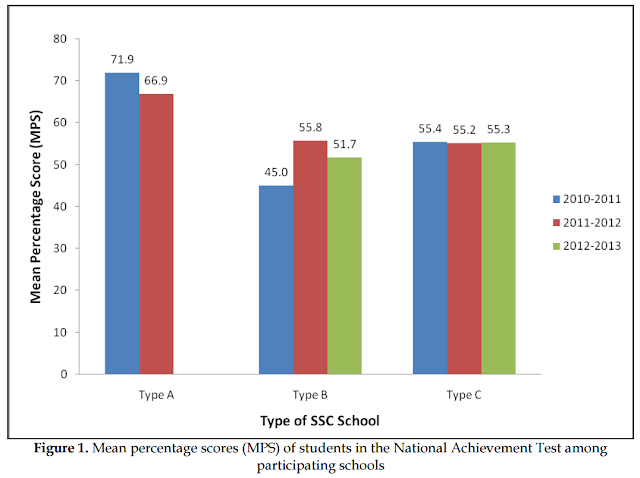The first step in solving a problem is admitting that there is a problem. The second step is understanding the problem. It is obvious to everyone that basic education in the Philippines is not in a good state so at least the first step is accomplished. The second step, understanding the problem, turns out be a lot more difficult for there is a natural tendency to prejudge and immediately offer solutions. DepEd's K to 12 is one example, as this gigantic reform fails to comprehend what is really plaguing schools in the Philippines.
There is a research paper from the Philippines that exemplifies how we often wrongly approach a predicament. The
paper authored by Bangcaya and Alejandro is published in the European Journal of Science and Mathematics Education. It starts with correctly recognizing the problem: Students enrolled in special science classes like students in regular classes in Philippine schools perform poorly in standardized exams.
The three types of special science classes labeled in the above figure are: A, (old) with support from the Department of Science and Technology - Science Education Institute (DOST-SEI), B, (new) with DOST-SEI support, and C, (existing)
without DOST-SEI support. This observation is no different from the results from international testing in 2008.
Aside from students from the Philippine Science High School, students in other special science classes in the Philippines, unlike students from other countries, are not even reaching intermediate benchmark scores in mathematics. Things have really not changed over the course of five years. Special science classes in the Philippines are still ineffective. It is indeed straightforward to see the problem. However, the title of the paper,
School-related factors contributing to the delivery enhancement of
the special science program in Western Visayas, Philippines, demonstrates how a problem can be grossly misunderstood. In search of a solution, special attention is given to the observed difference between the scores of students from type A schools and those from B and C. This is despite the fact that students from type A schools likewise miss the 75 percent mark. The authors therefore try to look for something that is unique in type A schools, failing to recognize that all schools are really not performing well. One possible area is curriculum implementation and for this area, the authors simply use a survey.
There is not even a minute variance in this survey with all schools reporting a mean of 4.00 (the highest possible rating) in all areas of curriculum implementation. Other factors such as extracurricular science-related activities are then examined.
The authors therefore conclude that these activities are behind the "better" performance of students from type A schools. If one follows the conclusion of this paper, then it seems that holding science contests is the way to go to improve science education in the country. This, of course, is not going to work. Such conclusion unfortunately results from misunderstanding the problem.
First, in making a comparison, it is important that there is random sampling. Students by virtue of being enrolled in special science classes are not randomly picked.
One high school in the Philippines, for example, specifically states on its
website,
"To ensure that earners are qualified and truly deserving to be in the program, all prospective first year enrollees are required to undergo rigid screening and pass a DOST prescribed selection test. Grade requirement of enrollees is 83% in English, Science and Mathematics with a general average of 85%. Once in the program, it is imperative for a Special Science Class (SSC) student to maintain a grade not lower than 80% in any subject area and a general average of 85%."
No step has been taken in this study by the authors to check if the students from type A schools are different right at the starting point of high school from those of type B and C schools.
Nonetheless, focusing and looking for the difference is the first mistake in this paper. The more important thing is that all schools are not performing well, thus, one must look not for something that is special with one type of school but for something that is general across all schools. A
previous post in this blog in which the following table is highlighted provides an important clue.
 |
Above copied from
Blömeke, S., Suhl, U., Kaiser, G., & Döhrmann, M. (2012). Family background, entry selectivity and opportunities to learn: what matters in primary teacher education? An international comparison of fifteen countries. Teaching and Teacher Education, 28, 44–55.
|
The above scores are for math teachers in elementary school, but the results for secondary or high school teachers are not different. Likewise, secondary teachers from the Philippines score very low in mathematics content knowledge.
Understanding the problem in basic education leads us to where solutions must be applied. The problem originates from teacher preparation. The problem Philippine basic education faces comes from higher education. Teaching schools and universities are the ones not delivering. Holding science contests, quizzes, workshops do not really address the problem. With this perspective, it is also easy to see that changing the curriculum in basic education is not the solution. DepEd K to 12 for instance does not address the lack of competency of teachers. The problems must first be addressed in higher education.







Comments
Post a Comment